Chloé Perdrix writes: Vietnam and Laos
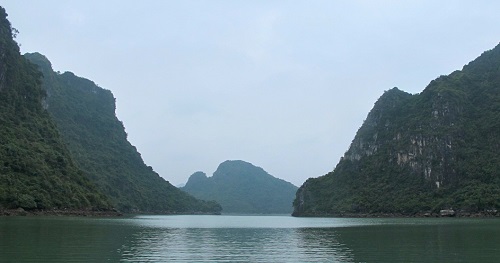 My name is Chloé Perdrix, I’m a 27 year old French GP resident,. I am taking a sabbatical year travelling around Asia. In order to stay in touch with the medical network, I intend to meet general practitioners during this journey. I proposed to WONCA and the Vasco da Gama Movement (VdGM), to write an article each two months in order to share my discoveries, my questions and my reflections about this experience. This is my fourth story.. to see others click here.
My name is Chloé Perdrix, I’m a 27 year old French GP resident,. I am taking a sabbatical year travelling around Asia. In order to stay in touch with the medical network, I intend to meet general practitioners during this journey. I proposed to WONCA and the Vasco da Gama Movement (VdGM), to write an article each two months in order to share my discoveries, my questions and my reflections about this experience. This is my fourth story.. to see others click here.
Agent Orange in Vietnam
After our bike trip detailed in my previous article, we arrived in Mekong Delta and moved toward the North Vietnam. During our Halong Bay visit (photo above), we hiked on an Island named Cat ba. There, we met a French nurse who explained her work experience in Ho Chi Minh. She told us how surprised she was to see how Vietnamese people took care of their relatives. All her patients were always accompanied by a family member.
Family in Asia is very important. Children and parents often live in the same house all their lives. Children taking care of their parents when they get older. No old people live alone.
She also told us about patients who were victims of Agent Orange.(1)(2)(3) To explain, Agent Orange was a powerful mixture of chemical defoliants (X 50 times standard levels) used by US military forces during the Vietnam War to eliminate forest cover for North Vietnamese and Viet Cong troops (in South Vietnam), as well as to eliminate the crops that might feed them. The data say the more than 20 million gallons of herbicides were sprayed over 5 million acres of land in Vietnam from 1961 to 1971.
Agent Orange contained the chemical dioxin. In addition to the massive environmental impact of the defoliation, it was later revealed to cause serious health issues among the Vietnamese population and US veterans.
The US Institute of Medicine’s July 2009 report cited sufficient evidence of association between exposure to Agent Orange/dioxin and five illnesses: soft-tissue sarcoma, non-Hodgkin’s lymphoma, chronic lymphocytic leukaemia (including hairy-cell leukaemia), Hodgkin’s disease, and chloracne. The report also found evidence suggesting an association with prostate cancer, multiple myeloma, amyloidosis, Parkinson’s disease, porphyria cutanea tarda, ischemic heart disease, hypertension, Type 2 diabetes, peripheral neuropathy, cancers of the larynx/ lung/ bronchi/ trachea, and spina bifida in exposed people’s offspring.
In Vietnam, the Vietnamese Red Cross also associates the following with exposure to dioxin: liver cancer; lipid metabolism disorder; reproductive abnormalities and congenital deformities such as cleft lip, cleft palate, club foot, hydrocephalus, neural tube defects, fused digits, muscle malformations and paralysis; and some developmental disabilities.
Vietnam has reported that some 400,000 people were killed or maimed as a result of exposure to herbicides like Agent Orange. In addition, Vietnam claims half a million children have been born with serious birth defects, while as many two million people are suffering from cancer or other illness allegedly caused by Agent Orange.
I was very surprised by this story and disappointed to realise that even when the war is long over, there are still consequences on the environment and for public health in Vietnam.
If you want to know more about it, here is a very
good video to inform people about Agent Orange effects in Vietnam. (4)
Tet in Laos
After Vietnam, we went back to Laos to visit the north of the country. After three wonderful days kayaking on the Nam Ou River, we arrived in Luang Prabang. There, it was very hard to find a room because it was the 21 February, two days after the “Tet celebration” (Chinese and Vietnamese New Year).
There were a lot of Chinese tourists on vacation in Luang Prabang. Consequently, all guesthouses in downtown were full. Fortunately, my brother, Romain and I found a room in the Luang Prabang suburbs, whereas some of our kayaking friends had to sleep in the entrance hall of the hostel, on a mattress the owner gave to them.
But some of you must wonder: What is Tet? Tet is the occasion to express respect and remembrance for ancestors as well as welcoming the New Year with beloved family members.
In the past, Tet was essential as it provided one of few long breaks during the agricultural year, between the harvesting of crops and the sowing of the next ones.
To make it easier, westerners can imagine Tet as a combination of Christmas and New Year: every family will get together to have big meals, decorate Tet trees
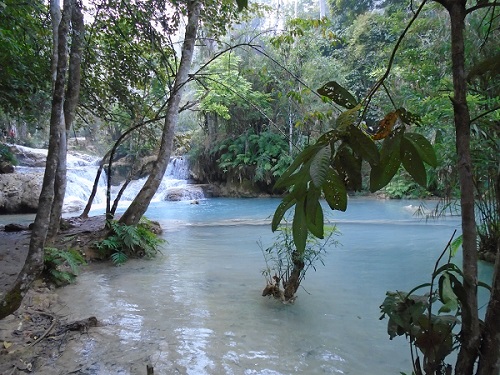
and eat Tet food but to welcome the New Year instead of for a religious cause. These celebrations can last from a day up to the entire week.
During Tet, one takes extra care not to show anger and not to be rude to people. The Tet is an occasion for people to share a common ideal of peace, concord and mutual love.
Bear bile traffic in Asia (5)(6)(7)
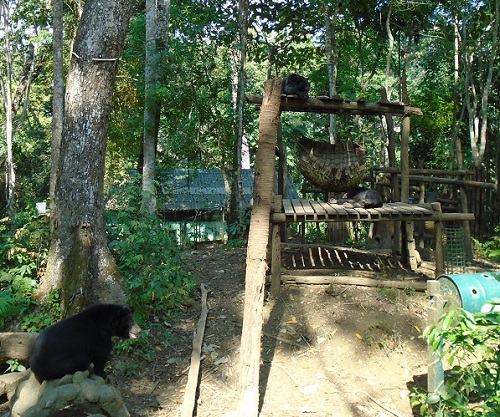
Once we found a room, we were advised to go to a beautiful waterfall where the water had a very special blue colour. (above photo) There, we discovered a bear refuge (photo at right) which protected bears from bear bile traffic.
I learned how traditional medicine could be sometime so inhuman. (Without forgetting that western medicine can also be inhuman sometimes.)
Bears in Asia are captured for their bile, which is extracted using cruel, painful procedures and sold as traditional medicine.
Bear bile contains high levels of ursodeoxycholic acid (UDCA) known to be useful for treating liver and gall bladder conditions. However, there are now many readily available herbal and synthetic alternatives with the same medicinal properties.
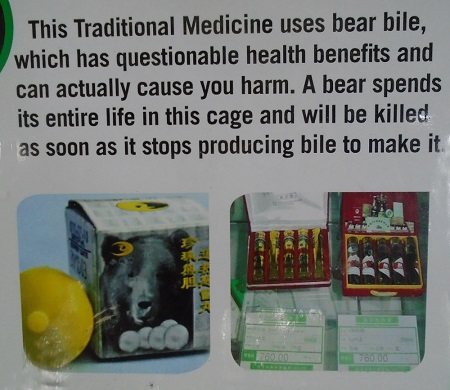
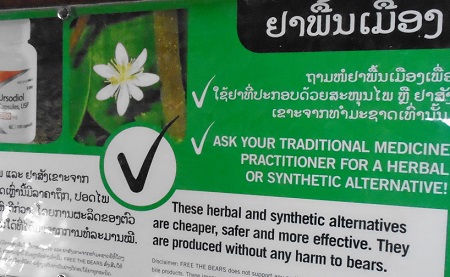
Despite the availability of inexpensive and effective herbal and synthetic alternatives – and the dangers of consuming bile from sick bears – bile farming continues.
Bear bile has been used in traditional Asian medicine for thousands of years. In the past bear bile would be obtained by hunting bears in the wild and killing them to remove their gall bladder. It would have been a particularly rare and prized ingredient at the time used sparingly for specific medical conditions.
These captive bears suffer in filthy and cramped conditions, often in cages no bigger than phone booths. In China, the cages are sometimes so small that the bears are unable to turn around or stand on all fours. Some bears are caged as cubs and never released. Bears may be kept caged for up to 30 years.
More than 10,000 bears – mainly moon bears but also others such as sun bears and brown bears – are kept on bile farms in China, and just under 2,000 suffer the same fate in Vietnam. The bears are "milked" regularly for their bile, which cause massive infections. Most farmed bears are starved, dehydrated and suffer from multiple diseases and malignant tumours that ultimately kill them.
Demand for bear bile products comes mainly from China, Japan, Korea, Vietnam, Malaysia and Chinese Taipei. Bear bile products are also found in Australia, Indonesia, Laos, Myanmar, Singapore, the US and Canada.
Unfortunately, bear bile farming is still completely legal in China. In Vietnam, bear bile farming has been technically illegal since 1992, but it wasn’t until 2005 that species-specific legislation was introduced banning the exploitation of these endangered animals. Sadly, bear bile farming persists in the country due to legal loopholes as well as the fact that demand still exists.
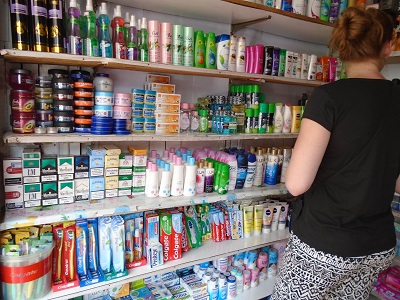 Moving on
Moving on
After visiting Luang Prabang, we flew to Mandalay, former capital of Myanmar. I met in Mandalay and Yangon wonderful family doctors who taught me a lot about Myanmar primary care and Myanmar culture. But you must wait the next article because I need an entire article to tell you about Myanmar.
Photo: cigarettes on sale in a Luang Prabang pharmacy
I hope this one interested you.
Chloé
Bibliography :
1. Agent Orange Record [Internet]. [accessed 17 March 2015]. Available at: http://www.agentorangerecord.com/home/
2. Health Effects [Internet]. The Aspen Institute. [accessed 17 March 2015]. Available at: http://www.aspeninstitute.org/policy-work/agent-orange/health-effects
3. Make Agent Orange History [Internet]. [accessed 17 March 2015]. Available at: http://makeagentorangehistory.org/
4. Make Agent Orange History [Internet]. 2010 [accessed 17 March 2015]. Available at: https://www.youtube.com/watch?v=Zx1f9hebiGg&feature=youtube_gdata_player
5. 5 Things You Need to Know About Bear Bile Farming [Internet]. One Green Planet. [accessed 18 March 2015]. Available at: http://www.onegreenplanet.org/animalsandnature/things-you-need-to-know-about-bear-bile-farming/
6. End Bear Bile Farming [Internet]. [accessed 18 March 2015]. Available at: https://www.animalsasia.org/intl/our-work/end-bear-bile-farming/
7. Ending the bear bile industry | World Animal Protection International [Internet]. [accessed 18 March 2015]. Available at: http://www.worldanimalprotection.org/our-work/animals-wild/ending-bear-bile-industry
Note: The views expressed and research conducted is that of the author and not necessarily the views of WONCA.